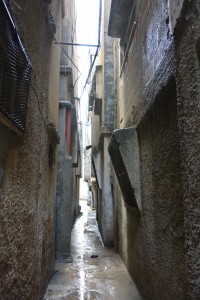Of the nineteen official refugee camps that make up the West Bank, next to Nablus, Balata is the most densely populated. Created in 1950 following the Arab-Israeli war, it now houses over 23,000 people.
Life in Balata is nothing like life in a castle…
“Young Palestinians in the camp, discouraged, sometimes approach Israeli check points with large bundles on their backs. They hope that the soldiers will confuse them with terrorists carrying explosives and will shoot them,” explains a professor in Balata, hired by the UNRWA (the United Nations Relief and Works Agency for Palestinian Refugees in the Near East).
If these young people decide to take this dark path, it’s because the one that awaits them, doesn’t seem any brighter . In addition, the camp in Balata offers a professional perspective as narrow as the streets that conform it. with an unemployment rate of 25 percent.
 …but rather a prison
…but rather a prison
In an area of 2.5 square kilometers, high concrete buildings soar into the sky, leaving between them a small space where even a child feels cramped.
Dirty alleyways to the four overpopulated schools of the UNRWA, the activities for children are limited, like the space to dream.
Children’s daily life is rocked by the problems of poverty, hygiene, water, electricity and waste treatment… In summer, due to Israeli restrictions, water only runs four days per week.
The disenchanted crucible
The majority of young people are left to themselves, parents, disillusioned by their situation or gone to work, leave their children to wander barefoot through the streets of the camp. This environment is the ideal grounds for “drugs and crime, which are real problems”, as testified by the Palestinian professor. It’s also the ideal crucible of disenchantment that burns all hope…
Or almost, since in the heart of the citizens of Balata, there is always “the right to return”.
Written by: Laurine Jobin Translated by: Emma Serianni Proofread by : Yoleth Lainez |

